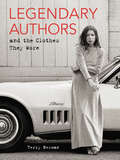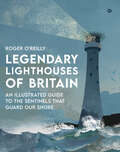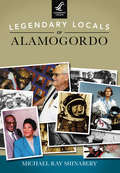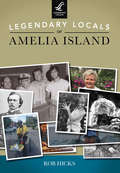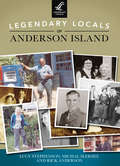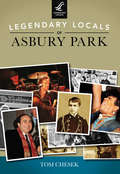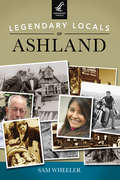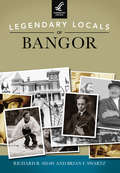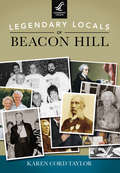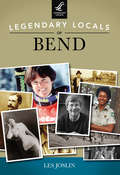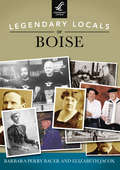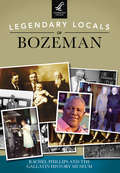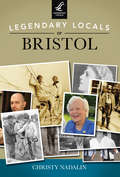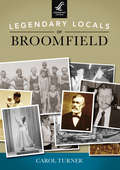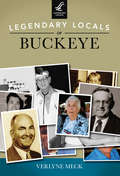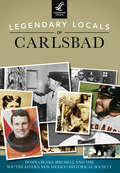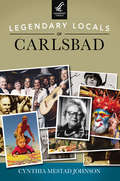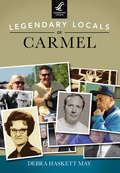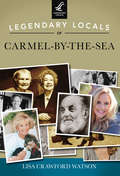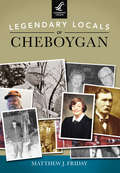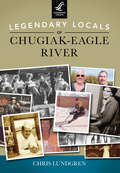- Table View
- List View
Legendary Authors and the Clothes They Wore
by Terry NewmanDiscover the signature sartorial and literary style of fifty men and women of letters, including Maya Angelou; Truman Capote; Colette; Bret Easton Ellis; Allen Ginsberg; Patti Smith; Karl Ove Knausgaard; and David Foster Wallace; in this unique compendium of profiles—packed with eighty black-and-white photographs, excerpts, quotes, and fast facts—that illuminates their impact on modern fashion.Whether it’s Zadie Smith’s exotic turban, James Joyce’s wire-framed glasses, or Samuel Beckett’s Wallabees, a writer’s attire often reflects the creative and spiritual essence of his or her work. As a non-linear sensibility has come to dominate modern style, curious trendsetters have increasingly found a stimulating muse in writers—many, like Joan Didion, whose personal aesthetic is distinctly "out of fashion." For decades, Didion has used her work, both her journalism and experimental fiction, as a mirror to reflect her innermost emotions and ideas—an originality that has inspired Millennials, resonated with a new generation of fashion designers and cultural tastemakers, and made Didion, in her eighties, the face of Celine in 2015. Legendary Authors and the Clothes They Wore examines fifty revered writers—among them Samuel Beckett; Quentin Crisp; Simone de Beauvoir; T.S. Eliot; F. Scott and Zelda Fitzgerald; Malcolm Gladwell; Donna Tartt; John Updike; Oscar Wilde; and Tom Wolfe—whose work and way of dress bears an idiosyncratic stamp influencing culture today. Terry Newman combines illuminating anecdotes about authors and their work, archival photography, first-person quotations from each writer and current designers, little-known facts, and clothing-oriented excerpts that exemplify their original writing style. Each entry spotlights an author and a signature wardrobe moment that expresses his or her persona, and reveals how it influences the fashion world today. Newman explores how the particular item of clothing or style has contributed to fashion’s lingua franca—delving deeper to appraise its historical trajectory and distinctive effect. Legendary Authors and the Clothes They Wore is an invaluable and engaging look at the writers we love—and why we love what they wear—that is sure to captivate lovers of great literature and sophisticated fashion.
Legendary Lighthouses of Britain: Ghosts, Shipwrecks & Feats of Heroism
by Roger O'ReillyPacked with legends, sea lore and exciting true-life tales, this is a highly giftable treasure trove of Britain's top 100 lighthouses, each one illustrated by award-winning artist Roger O'Reilly.This is a unique celebration of 100 of the most dramatic and storied lighthouses along the coasts of Britain. Illustrated with fantastic retro art by award-winning artist Roger O'Reilly, this guide to the sentinels that guard Britain's shores is aimed at walkers, art lovers, maritime and countryside enthusiasts, and anyone who just loves lighthouses!.From the Lizard in Cornwall to Muckle Flugga at the northern tip of the Shetlands, and out to the forbidding rock stations that lie offshore in the path of ferocious and unforgiving seas, Roger O'Reilly has selected the very best of Britain's lighthouses with all their sea legends, folklore and tales of ghosts, shipwrecks and endurance. Including:Souter on the Sunderland coast, reputed to be haunted by Grace Darling&’s niece Isabella, who lived here in the late 1880s. Staff have reported spoons floating in mid-air, unexplained temperature drops, and even being clutched by unseen hands.Ardnamurchan in the far west of Scotland, so remote that its builders came down with scurvy, and fresh fruit and vegetables along with a doctor had to be shipped out to help them.Trinity Buoy Wharf – who knew there was a lighthouse in the heart of London? It's now home to the Longplayer, a continuous 1,000-year long piece of music that will run until 31st December 2999.Smalls, off the Pembrokeshire coast, where in 1801 one keeper died and the other went mad, waiting almost four months for rescue while his dead colleague, fastened to the outside rail because the corpse had started to decompose, stared through the window at him accusingly.Lundy South, occupied by Barbary pirates during the 1600s, and in the 18th century the base of Thomas Benson, one time MP for Barnstaple and Devon&’s most notorious smuggler.
Legendary Locals of Alamogordo (Legendary Locals)
by Michael Ray ShinaberyBy the time Alamogordo's founders platted the town in the late 1800s, bestowing it with the Spanish name for Fat Cottonwood, the region's lush grasses were luring cowboys such as Oliver Lee. Then, in 1941, an event more than 3,000 miles away changed the quiet community. When the Japanese bombed Pearl Harbor, chamber president Mose Cauthen quickly spearheaded bringing the Army's mission to train bomber pilots to the Tularosa Basin. During the Space Race, Dr. John Stapp oversaw the programs at Holloman Air Force Base that sent Joe Kittinger, Dave Simons, and "Demi" McClure floating heavenward underneath balloons. Soon after, Ed Dittmer was training chimpanzees to rocket out of Earth's atmosphere and prove man could survive in that hostile environment. Alamogordo is where the Old West melds with ever-evolving technology, along with a rich artistic and literary legacy championed by such women as Linnie Townsend, Maude Rathgeber, and Margaret Flickinger.
Legendary Locals of Albuquerque (Legendary Locals)
by Richard MelzerSpanish settlers founded Albuquerque in 1706, making it the third of only four villas (towns) in colonial New Mexico. Located in the Rio Abajo along a wide turn on the Rio Grande, the settlement developed from a small farming community into New Mexico's largest, most modern city. Many notable men and women participated in this remarkable growth, lending their talents and sacrificing their time, energy, and sometimes their very lives. Dozens of these legendary figures are portrayed in this unique book, with chapters devoted to those who played important roles in politics and diplomacy; the military; law and order; religion and education; art and literature; culture and entertainment; business and tourism; health, science, technology, and space; and sports. A final chapter describes several of Albuquerque's sung and unsung heroes. The result is a collage of a Western city filled with diversity, tradition, and cultural pride.
Legendary Locals of Ambler
by Frank D. QuattroneOne of the few towns in America named after a woman, Ambler derives its driving spirit of selflessness and community from the heroine of the Great Train Wreck of 1856. Mary Ambler, a humble Quaker mill owner who came to the aid of dozens of disaster victims, may have been the first of countless Ambler personalities who have devoted themselves to the greater good of the thriving little borough located just outside Philadelphia. Legendary Locals of Ambler celebrates the lives of the sung and unsung heroes--political and civil servants, businessmen and builders, restaurateurs and devotees of the arts, and founders of charitable institutions, such as Henry G. Keasbey and Richard V. Mattison, William E. Strasburg, George E. Saurman, "Bud" Wahl, Mattie Dixon, and Peggy Dolan--whose contributions have made a significant difference in the lives of so many.
Legendary Locals of Amelia Island (Legendary Locals)
by Rob HicksAmelia Island has been host to remarkable people throughout its 500-year history. These people are responsible for giving Amelia the distinction as the only place in the United States to have seen eight different flags. A new railroad followed the Civil War and brought those who sought to take advantage of the burgeoning shipping center. As opportunities waned, the island became a sleepy, blue collar community supported by the local paper mills. Prior to civil rights legislation desegregating the South, Fernandina’s American Beach flourished as an African American coastal community. Meanwhile, local visionaries oversaw tight-knit communities and set the stage for the large resorts that came to the island’s south end in the 1970s. Today, Amelia Island is a national tourist destination and home to a diverse of community of longtime residents and newcomers, both with remarkable talents and interesting stories to tell.
Legendary Locals of Anderson Island
by Rick Anderson Lucy Stephenson Michal SleightFrom explorer Peter Puget to bachelor Johnson Brothers, whose farm became a regional museum, Legendary Locals of Anderson Island chronicles the emergence of a way of life that unfailingly awakens echoes of days long past. Anderson Island, the southernmost of all islands in Washington State's Puget Sound, was settled in the late 1800s by immigrants predominantly from the Scandinavian countries. They naturally brought with them and practiced their old-country ways of navigating, farming, and building. In time, due to its remoteness and relative inaccessibility, a society of self-reliant yet closely connected residents took root. The subsistence farming, logging, and fishing practiced by the early pioneers have mostly given way to cottage industries or daily commutes to the mainland. While retirement has become the majority occupation of today's islanders, a vibrant community life continues to flourish, centered around activities sponsored by the island's numerous volunteer-staffed organizations.
Legendary Locals of Arvada
by Tanya LongUnique characters have always made up the landscape of Arvada. Pioneers, ranchers and farmers, business leaders, community-minded individuals, doctors, sports figures, and even a Broadway star have all called home the city on a bluff overlooking Clear Creek. Benjamin Wadsworth was not only one of Arvada's founding fathers but also the town's first postmaster, and he donated many parcels of land for schools and churches to be built in the burgeoning town. Lloyd King, in 1947, opened the first King Soopers grocery store in Arvada. From this one small market grew an empire of more than 100 King Soopers stores in Colorado. Popular radio personality Irv Brown is known as "Denver's go-to guy" for sports talk. Brown coached at Arvada High School during the 1960s, leading the Redskins to 10 conference football titles and one state championship. And two-time Cy Young Award-winner Roy Halladay honed his baseball skills in Arvada as a youth. The starting pitcher for the Philadelphia Phillies graduated from Arvada West High School in 1995. From Louis Ralston's discovery of gold in 1850 along the creek that bears his name, to the present day sprawling suburb, Arvada's people have helped make the town a jewel of the Centennial State.
Legendary Locals of Asbury Park
by Tom ChesekIt is a pious paradise wrested from the dunes; a salty carnival of dreamers, drifters, and just plain folks; a city made legendary by Bruce Springsteen and Stephen Crane but grounded in generations of turbulent American reality. Even those who never lived there feel proprietary about Asbury Park--a place of shared experiences and strong passions, where grand sandcastle plans wash up against changing times and tides. Legendary Locals of Asbury Park captures a parade of personalities, from the visionaries who challenged nature to the true believers who sought, against tremendous odds, to make a year-round life in this city of summers. The shopkeepers and show people, the advocates on the front lines of social change, and the chroniclers who witnessed history are all among those who helped a small town cast a giant profile, here and on the big boardwalk beyond.
Legendary Locals of Ashland (Legendary Locals)
by Sam WheelerA century and a half of close-knitted community spirit, independent-mindedness, and a strong sense of stewardship have uniquely melded into present-day Ashland. Behind that patchwork of local ingenuity, artistry, and infamy are the faces of thousands--too many of whom are not mentioned within the pages of this book. There were hundreds of generations of Shasta Native American families that lived off the hills and creeks where Ashland now sprawls, but their abodes were abandoned and replaced by the lumber and flour mills, cleared streets, and painted homes of Ashland Mills. The sense of spirit and enthusiasm instilled by Ashland's early settlers bred the town's participation in the Chautauqua cultural movement, the remnants of which harbor Ashland's world-renown Oregon Shakespeare Festival, which paved the way for a former mill town's future prosperity. That spirit of ingenuity and artistry continues to shape Ashland and attracts hundreds of thousands of visitors annually to the quaint town nestled below the mighty crest of Siskiyou Pass along the Oregon-California border.
Legendary Locals of Bangor
by Richard R. Shaw Brian F. SwartzSince its settlement in 1769, Bangor's greatest resource has been its people. Long before 1834, when the town on the Penobscot became a city, future legends were born who transformed it into a world-class community. Hannibal Hamlin served as Abraham Lincoln's first vice president. Timber tycoon Sam Hersey financed urban development while less affluent folk such as Molly Molasses also made their mark. When philanthropists Stephen and Tabitha King are not writing best-selling novels, they are spreading their wealth throughout the community. Bangor's melting pot includes the Italian Baldacci family and the Jewish baker Reuben Cohen, who, with his wife Clara, raised their son Bill, a US senator and defense secretary. More infamous but equally legendary is brothel keeper Fanny Jones. Paul Bunyan earned a statue on Main Street. Airport troop greeters Kay Lebowitz and Bill Knight round out the list of notables. They are all jewels in Bangor's crown, and each in their own way is a bona fide legend.
Legendary Locals of Beacon Hill (Legendary Locals)
by Karen Cord TaylorIn the 1600s, William Blaxton set up his farmstead on Beacon Hill because it was far from the bustle of the city. John Hancock's uncle Thomas Hancock built his mansion on the hill in the 1700s so he could enjoy a rural lifestyle. In the early 1800s, future mayor of Boston Harrison Gray Otis moved to Beacon Hill because it was the new and fashionable neighborhood he was helping create. Louisa May Alcott, in the 19th century, and Robert Frost, in the 20th, lived on the hill because the literary set loved the neighborhood's picturesque streets and close quarters that made it easy to get together for conversation. The 9,000 residents who live in this small, urban neighborhood of Boston today appreciate its walkability, convenience, quirkiness, and neighborliness. The historic architecture, ever-burning gas lamps, rugged bricks, and one-of-a-kind shops prove that the best of the past can live comfortably with the novelty of the present.
Legendary Locals of Bend (Legendary Locals)
by Hays County Historical Commission Les JoslinA fascinating mix of local legends who could be characterized as "the right people, in the right place, at the right time" arrived in Central Oregon during the past century and a half to make Bend the fascinating city it has become. Some of these people--explorer John Charles Fremont, publisher George Palmer Putnam, economist William A. Niskanen, and "World's Greatest Athlete" Ashton Eaton among them--gained national prominence and even global stature. Others were and are more ordinary people who have done and continue to do extraordinary things in an extraordinary place, a small but singular city of some 80,000 souls astride the Deschutes River at the eastern foot of the Cascade Range.
Legendary Locals of Boise (Legendary Locals)
by Barbara Perry Bauer Elizabeth JacoxBoise of the 21st century is very different from the tiny community established in 1863 at the crossroads of the Oregon Trail and the road to the Boise Basin gold mines. Originally known as "Boise City," it existed as a distribution center for supplies and fresh food for miners. The development of irrigated agriculture and the expansion of transportation networks during the 20th century and an influx of pioneers from many regions of the United States helped the city grow into a technology center during the 21st century. Early residents like Tom and Julia Davis helped create a city filled with green parks and walking paths; author and illustrator Mary Hallock Foote brought Boise to the attention of the nation with her writing and illustrations; businessmen J.R. Simplot and Joe Albertson established local businesses that grew to national companies. The music of Curtis Stigers, the literature of Anthony Doerr, and the athletic prowess of Kristin Armstrong have helped focus attention on Boise, which is now recognized as one of the country's most livable communities.
Legendary Locals of Bozeman (Legendary Locals)
by Rachel PhillipsFrom its inception as a supply town during Montana's gold rush in the 1860s, Bozeman has attracted visionaries, leaders, and pioneering thinkers. Bozeman's first mayor, John V. Bogert, established a precedent for keeping the city clean, safe, and orderly. City commissioner and tireless worker Mary Vant Hull spearheaded efforts to build a new library and to expand local parks and trails, and early physician Dr. Henry Foster successfully performed one of the first caesarean sections in Montana. Incredibly talented outdoor advocates and athletes like mountain climber Alex Lowe and long-distance runner Ed Anacker have complemented Bozeman's outdoor lifestyle. An emphasis on art, music, and culture began in the 1860s with piano and voice sensation Emma Weeks Willson. Today, artist Jim Dolan's sculptures are enjoyed all over town, and illusionist Jay Owenhouse wows children and adults with his live shows. Inspiring individuals like Cody Dieruf, who passed away from cystic fibrosis at the age of 23, and dedicated streetcar driver Larry O'Brien have added kindness and courage to local life.
Legendary Locals of Bristol
by Christy NadalinThe story of Bristol is the story of America, played out on the small stage of a lobster claw-shaped peninsula at the heart of Narragansett Bay. From the massacre and displacement of the first Americans to the rise of the merchant class; exploration; slavery; war and peace; the Industrial Revolution; waves of immigration--all these wildly disparate facets of the American experience have been represented and reflected within these 20 square miles. Bristol has been home to patriots and pirates; ministers and murderers; captains who dominated at the helms of whalers, battleships, and 12-meter sailboats; larger-than-life industrialists; Hollywood and Broadway royalty; artists, writers, musicians, and culinary visionaries. But the bulk of the threads in Bristol's remarkable tapestry are not bold-colored silk, bright metallic, or rich cashmere--most are simple and natural, unremarkably structured and hued, but each one quietly doing its part to form the strong, tightly-woven foundation of this very special place.
Legendary Locals of Broomfield
by Carol TurnerThe city of Broomfield had its beginnings in the "howling wilderness" of the late 1850s. At first, the settlement was little more than two stage stops along a treacherous route to California. The Church family operated Church's Crossing Stage Stop, a day's ride from Denver on the Overland Trail. Over many years, other pioneer families settled in: the Graves and Crooks families, the Browns, Nissens, Wrights, Koziseks, Archers, Hansens, Shaws, Brunners, and more. Some of these families claim five or six generations in the area. A century passed before Broomfield began to grow into the city it is today. In the late 1950s, a group of investors began building Broomfield Heights. As young families began moving in, the farm community was transformed into a suburban city, guided by local notables such as Don DesCombes, George Di Ciero, and others. Perhaps the most admirable aspect of the city's history is the enormous amount of work done by community-minded volunteers. Their story is one of selfless enthusiasm, of hard work with no reward except a better place to live.
Legendary Locals of Buckeye
by Verlyne MeckIn 1884, Malie Monroe Jackson began and named a canal Buckeye in honor of his native state, Ohio, the Buckeye state. In 1886, Thomas Newton Clanton added 10 miles to the canal. The following year, he applied for a post office, and on March 10, 1888, the post office, named Buckeye, was established. Clanton platted a townsite and named the town Sidney, though why he chose that name remains a mystery. Beginning in 1910, advances in transportation put the community on the map, and Sidney became Buckeye. Hugh Watson, founder of the Buckeye Valley Bank, became the town's first mayor in 1929. On January 1, 2014, Buckeye became the newest city in Arizona. This newest volume also celebrates today's Buckeye settlers, such as Levi Beard, Tony Youngker, Clemie Arnold, and Bob Doster, DVM, updating Buckeye's colorful history of notable residents.
Legendary Locals of Carlsbad
by Donna Blake Birchell Southeastern New Mexico Historical SocietyBorn from opportunity and a promotional scheme hatched by founding father Charles B. Eddy, Carlsbad started life as a tent city on a desolate landscape. As the investment money started to flow, the Pecos River was harnessed through the creation of irrigation, which turned the region into a rich, fertile valley. As tuberculosis swept the nation, hundreds of new settlers arrived in Carlsbad for the arid climate. Legendary Locals of Carlsbad celebrates their descendants who forged the community of today. Learn about socialite Cesarine Graves, daredevil and "Mr. Welcome" Frank Kindel, actors Dan Blocker and Bruce Cabot, drag racer Dick Harrell, newscaster Linda Wertheimer, astronaut F. Drew Gaffney, and baseball star Cody Ross, to name but a few. Included also are the tales of the trials and heroism shown and faced by all the veterans of wars that Carlsbad provided, especially the World War II veterans of the Bataan Death March, the Vietnam War, and the wars in Iraq and Afghanistan.
Legendary Locals of Carlsbad (Legendary Locals)
by Cynthia Mestad JohnsonA collision of cultures in a seaside resort community, Carlsbad sits on a seven-mile stretch of white-sands beach idyllically located on the Pacific coast of north county San Diego. The idea of Carlsbad began in the late 1880s when two small groups of entrepreneurs ascended, simultaneously, from both the north and the south. The first group discovered natural mineral springs, which they promoted to tourists as having healing powers. As a result, the town became a very popular resting point for the rich and famous when traveling by train from Los Angeles to the famed Del Mar horse races. Subsequently, the Mexican Revolution began to the south and drove a second group of visionaries to Carlsbad. Thus, the quaint downtown area, known as the Village, was created along with a vibrant Barrio. Incorporated in 1952, Carlsbad remains, today, a tight-knit community of multigenerational and uniquely talented locals.
Legendary Locals of Carmel (Legendary Locals)
by Debra Haskett MayEarly Carmel settlers Silas Moffitt and William Kinzer found the area to be abundant for hunting and the soil rich for farming. Quaker in origin, the town's quest for importance in education was forefront and remains so today. With other dedicated leaders through a time of rapid growth in the mid-20th century, Robert Hartman and Dale Graham set the standard to make Carmel High School a respected rival in academic, sports, and extracurricular competitions. Beautiful art galleries, anchored by the Evan Lurie Building, dot the rejuvenated downtown Arts & Design District where Colonel Trester's blacksmith shop and O.W. Nutt's hardware store once stood. A far cry from tented summer church revivals, world-class musicians and performers now take the stage of the Palladium, an acoustically perfect and visually magnificent performing arts center. Visionary mayor James Brainard seeks a sixth term and hopes to continue on the same path of growth and renewal. The city has been voted one of America's best places to live, and Carmel's varied and colorful residents have been proving this since the 1830s.
Legendary Locals of Carmel-by-the-Sea
by Lisa Crawford WatsonA place whose history has long been a source of fable and fascination, Carmel-by-the-Sea is a community whose ancestors summered by the sea and ultimately stayed through the seasons. After founders Frank Powers and Frank Devendorf populated the once-barren potato patches with artists and academicians, it became a place defined as much by legends and landscape as by the characters who came to Carmel. Whether it is the clear light that attracted photographers Edward Weston, Ansel Adams, Doug Steakley, and Bob Kolbrener; the whisper in the trees, the rhythm of the waves, and the stillness at dawn that seduced writers Mary Austin, Robinson Jeffers, Jack London, Bob Campbell, Rick Masten, and Jane Smiley; or the unbridled beauty in a majestic mountain, surging sea, or verdant valley that drew in artists Mary DeNeale Morgan, William F. Ritschel, E. Charlton Fortune, Mari Kloeppel, Carol Chapman, and Loet Vanderveen, the truth is that Carmel-by-the-Sea gets in one's soul and makes its home there.
Legendary Locals of Center City Philadelphia (Legendary Locals)
by Thom NickelsPhiladelphia is a hard mistress when it comes to honoring native talent, and the city has more than its fair share of notable figures. Consider colorful politicians like Frank Rizzo and Richardson Dilworth, international celebrities like Grace Kelly, sports legends like Connie Mack, Philadelphia Museum of Art icons like Anne d'Harnoncourt, or national radio personalities like Terry Gross. Business tycoons such as John Wanamaker and Russell Conwell, founder of Temple University, made many contributions to the city. Pearl Buck, author of The Good Earth, and Christopher Morley, America's G.K. Chesterton, created legacies of their own. Other legends like the nearly forgotten Agnes Repplier, a world-famous essayist and contemporary of Henry James, and poet Daniel Hoffman, the designated US poet laureate in 1973-1974, have helped enrich the city's literary reputation. There are Marian Anderson, Mario Lanza, and Hollywood actor Kevin Bacon, whose fame is equaled by his city planner father, Edmund. Architects like Frank Furness, Louis Kahn, and Vincent Kling helped transform the city into an international destination. And there are many notables looming outside the margins of this book, waiting for their day of discovery.
Legendary Locals of Cheboygan
by Matthew J. FridayFounded as a lumbering town in the mid-1800s, Cheboygan has transformed over the years to be something much less simplistic and much more dynamic; so, too, have its people. While some of Cheboygan's residents played important roles in business or commerce, others made their mark through philanthropic work, service to the community, or just by their demeanor. History is as much about people as it is about events--people like Gordon "Scoop" Turner, who came to Cheboygan for a few months but ended up staying for a lifetime. There are businessmen like Millard D. Olds, who became one of the most successful lumbermen at a time when others were leaving town, and George M. Humphrey, the 55th treasurer of the United States. An eye towards the community has also made some residents legendary, such as Joyce and Quincy Leslie. And, of course, there are those whose history is shrouded in controversy, including Sheriff Fred Ming, under whose authority a Native American village was burned to the ground. Whatever their story, these locals have contributed to the character and history of Cheboygan.
Legendary Locals of Chugiak-Eagle River
by Chris LundgrenHomesteading in Alaska was not an obvious lifestyle choice for most people in post-World War II America. In an age of gleeful consumerism, early settlers of Chugiak-Eagle River made a decision to live simply. Yet a simple life and an easy one were two different things. Many raised their own crops and a few, such as the Pippels, the Tatros, the Glenn Briggses, and the Vanovers, created larger-scale farming ventures. Other entrepreneurs, such as Paul Swanson, thrived in the frontier environment, taking on multiple enterprises to fill gaps in the area's services. Out of this can-do atmosphere sprang a number of artists, musicians, and performers. The Chugiak Belles dance group revved up audiences at the annual Spring Carnival, and the Chugiak Players staged a variety of dramas and comedies. Eagle River homesteaders Arthur and Eleanor Braendel helped found the Anchorage Symphony Orchestra and performed with them for 60 years. Radio host and homesteader Ruth Briggs sang and traveled with the original Anchorage Concert Chorus. As the area matured and schools grew, athletes began to thrive, creating their own legacy. More legendary locals are being minted every day.
